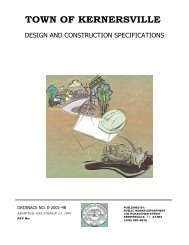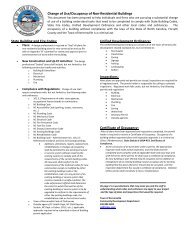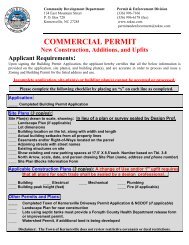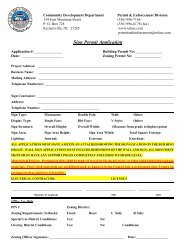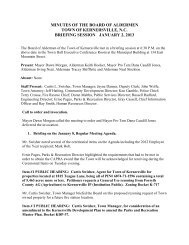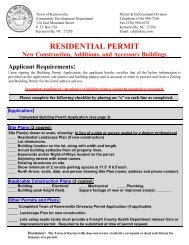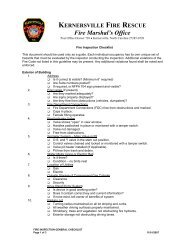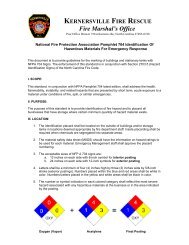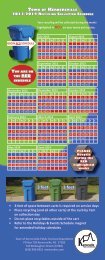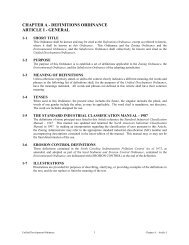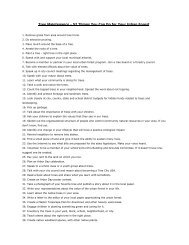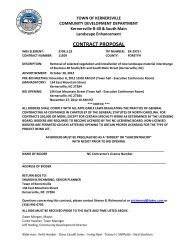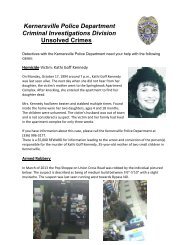Piedmont Greenway Master Plan - Town of Kernersville
Piedmont Greenway Master Plan - Town of Kernersville
Piedmont Greenway Master Plan - Town of Kernersville
- No tags were found...
Create successful ePaper yourself
Turn your PDF publications into a flip-book with our unique Google optimized e-Paper software.
The status <strong>of</strong> local lines could change in the future, depending on freight demand, and short-line railroads<br />
could be abandoned with only a brief public notice to indicate their intent. Therefore, all railroad lines in the<br />
region should be monitored periodically to determine their current status.<br />
the street system. Disadvantages include proximity to automobile traffic, lack <strong>of</strong> pedestrian scale,<br />
narrow roads and high volume intersections. Retr<strong>of</strong>itting public roadways for bicycle and pedestrian<br />
use must be coordinated with the appropriate local and state departments <strong>of</strong> transportation.<br />
Once a railroad has formally registered its intent to abandon a specific line, the rail bed can be preserved<br />
as a corridor for trail use through “rail banking.” The rail-banking program was created through the 1983 National<br />
Trails System Act to allow for conversion <strong>of</strong> rail lines for trail use. The window <strong>of</strong> opportunity for filing<br />
for rail banking requests is relatively narrow. If a line is rail-banked, the corridor is treated as if it had not<br />
been abandoned, and as a result the integrity <strong>of</strong> the corridor is maintained and this stops reversions to adjacent<br />
landowners. However, the line is subject to possible future restoration <strong>of</strong> rail service.<br />
Even if railroad lines are not abandoned, they can still be utilized as trail corridors in the future under<br />
a concept called “rails-with-trails.” Developing a rail-with-trail involves installing a multiuse public trail<br />
alongside an active railroad track in a way that is safe to all users. This approach is becoming an increasingly<br />
important tool in trail building efforts across the country, according to Rails-to-Trails Conservancy, an<br />
organization that has published a study evaluating 16 existing rails-with-trails. The study, “Rails-with-Trails:<br />
Sharing Corridors for Recreation and Transportation,” found that appropriately designed rails-with-trails are<br />
highly successful and extremely safe. (Source: Rails-to-Trails Conservancy, www.railtrails.org)<br />
On-Road Corridors<br />
In urban areas, greenway systems<br />
inevitably connect to the existing street<br />
system. In many cases, local streets are the<br />
only linear corridors available for bicycle<br />
and pedestrian use. Therefore, the most<br />
successful greenway systems across the<br />
country combine <strong>of</strong>f-road trails with an<br />
extensive on-road system <strong>of</strong> bicycle facilities<br />
and sidewalks. This type <strong>of</strong> network<br />
best suits the needs <strong>of</strong> people who bicycle<br />
and walk for transportation reasons since<br />
all major destination points connect directly<br />
to the street system.<br />
Some advantages <strong>of</strong> this approach include<br />
availability <strong>of</strong> publicly owned land,<br />
presence <strong>of</strong> paved shoulders and wide<br />
outside lanes along some roads, ease <strong>of</strong><br />
access and use and public familiarity with<br />
PIEDMONT GREENWAY<br />
Final <strong>Master</strong> <strong>Plan</strong> Report 21



